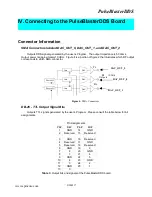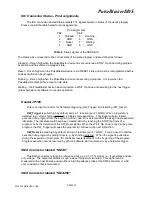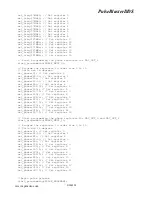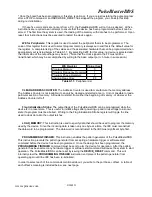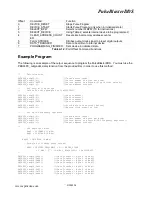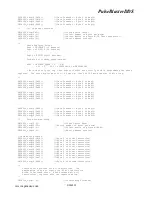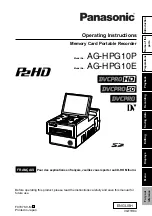
PulseBlasterDDS
IDC Connector Status - Pin Assignments
The IDC connector labeled Status outputs TTL signals based on status of the user’s program.
Please consult the table below for pin assignments.
Pin Assignments
Pin#
Pin#
1
Stopped
5
Running
2
GND
6
GND
3
Reset
7
Waiting
4
GND
8
GND
Table 4:
Status signals of the PBDDS-III
The status pins correspond to the current state of the pulse program and are defined as follows:
Stopped – Driven high when the PulseBlaster device has encountered a STOP Op Code during program
execution and has entered a stopped state.
Reset – Driven high when the PulseBlaster device is in a RESET state and must be reprogrammed before
code execution can begin again.
Running – Driven high when the PulseBlaster device is executing a program. It is low when the
PulseBlaster enters either a reset or idle state.
Waiting – the PulseBlaster device has encountered a WAIT Op Code and is waiting for the next trigger
(either hardware or software) to resume operation.
Header JP100
This is an input connector, for hardware triggering (HW_Trigger) and resetting (HW_Reset).
HW_Trigger
is pulled high by default, and pin 1 is active (pin 2 = GND). When a low state is
detected (e.g., when shorting pins 1-2), it initiates code execution. This trigger will also restart
execution of a program from the beginning of the code if it is detected after the design has reached an
idle state. The idle state could have been created either by reaching the STOP Op Code of a
program, or by the detection of the HW_Reset signal. When the WAIT Op Code is used in the pulse
program, the HW_Trigger will cause the program to continue to the next instruction.
HW_Reset
is pulled high by default, and pin 3 is active (pin 4 = GND). It can be used to halt the
execution of a program by pulling it low (e.g., by shorting pins 3-4). When the signal is pulled low
during the execution of a program, the controller resets itself back to the beginning of the program.
Program execution can be resumed by either a software start command or by a hardware trigger.
SMA Connector labeled “SMA0”
This SMA connector outputs the reference clock as a 3.3 V TTL signal, i.e., it generates positive-
only voltage. The output resembles a square wave if properly terminated. This signal can be
measured with an oscilloscope using either a high impedance probe at the SMA connector or a 50
ohm coaxial line that is terminated.
SMA Connector labeled “SMA400”
9/20/200518
www.spincore.com














